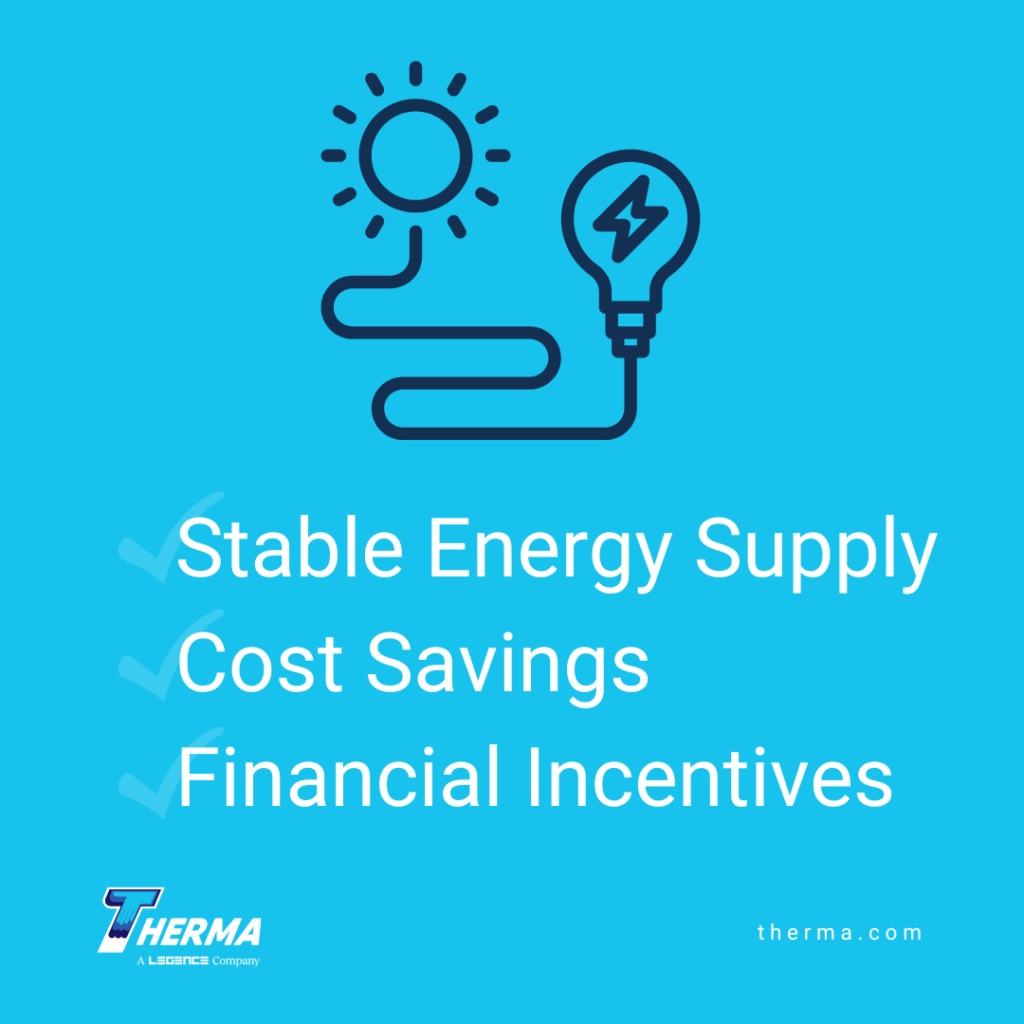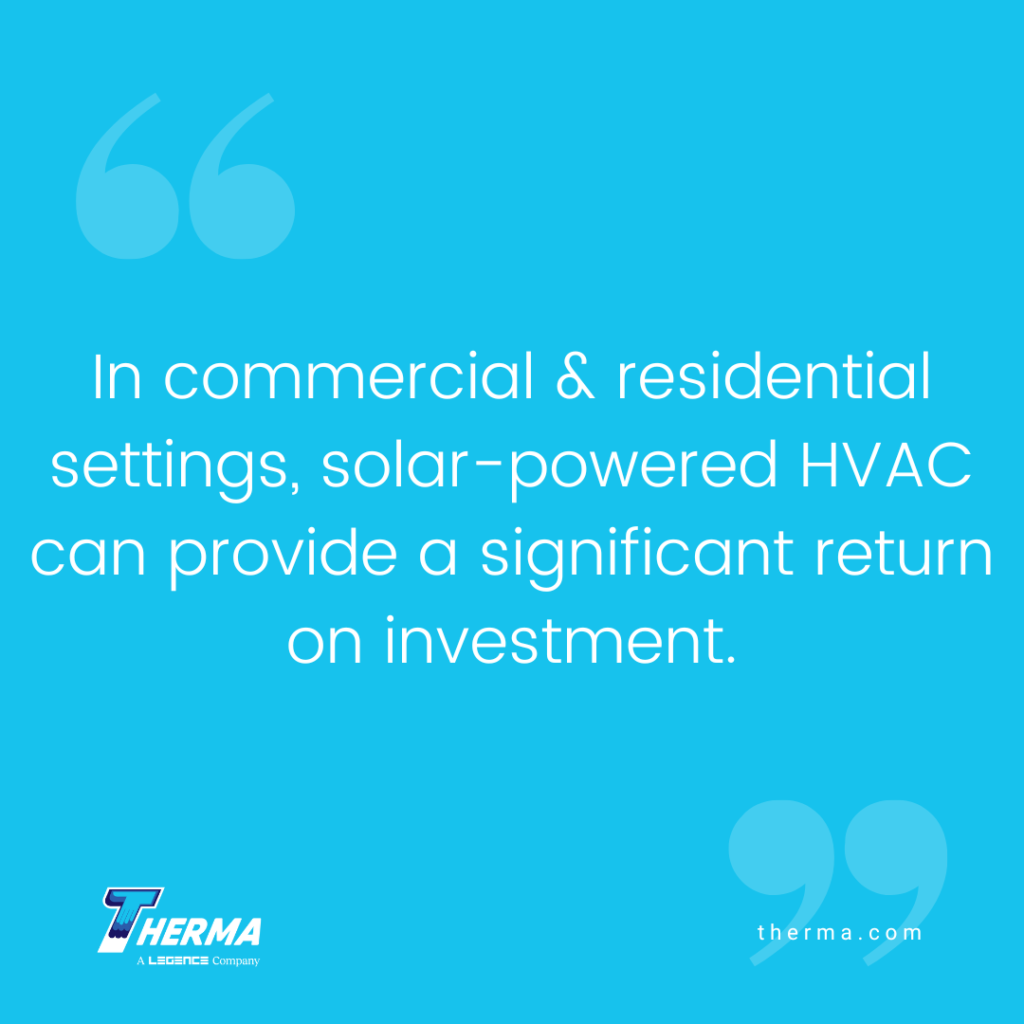by Ali Kriscenski
What are the benefits of solar powered HVAC systems? Traditional fuel sources and utility grids can be vulnerable to numerous disruptions including supply, capacity and even international conflicts. The ability to harness renewable energy for heating and cooling provides a wide range of benefits that allow for stable energy supply, cost savings and financial incentives.
Solar Energy at a Glance
Solar energy has long been utilized for heating and cooling in vernacular architecture which is sited and designed to harness or shield from the sun’s energy. Passive solar design utilizes strategies to control solar gain, concentrate thermal mass and distribute solar energy through convection, conduction and radiation. A modern example is seen in solar thermal energy systems where the sun’s energy is collected in a medium — such as water — and circulated to distribute heat throughout a building or its accessories, like swimming pools.
Solar photovoltaic (PV) systems which convert the sun’s energy into electricity are a technology that emerged in the United States late in the 20th century. While experimentation with solar and electrical interaction had been seen even in the 1800s, it wasn’t until 1954 when solar photovoltaic cells powered electrical equipment. Since then, solar PV has increased in efficiency and become widely used as a power source for space, transit, commercial and residential applications.
 Benefits of Solar Energy
Benefits of Solar Energy
The ever-present abundance of solar energy has always engaged great minds, including Albert Einstein who discovered the law of the photoelectric effect in 1921 and was awarded the Nobel Peace Prize for his work. As a renewable energy, solar has played a central role in sustainability efforts globally which has driven market innovation worldwide. In 2020, the global solar PV market size was USD $154.47 billion.
The large market demand for solar PV reflects its value in terms of meeting today’s energy requirements. Solar energy is a locally sourced resource that utilizes advancing technology. In commercial and residential settings, solar-powered HVAC can provide a significant return on investment that has a positive impact on long-term operating costs and revenue.
In some regions, especially those with high heating and cooling demand, solar energy for HVAC can be a cost-effective investment. Extreme temperatures can place increased demand on utility grids that are stretched to capacity in moderate weather. In Texas, an increase in population and economic growth coupled with extreme weather conditions has led to repeated power crises.
Applications for Solar-Powered HVAC
Unlike coal-powered electricity, solar power offers a way to harness renewable energy on-site for energy production. Solar PV can be used to generate electricity for appliances and lighting, but it also makes solar powered HVAC possible. There are several types of HVAC systems that can utilize solar power for heating and cooling.
Geothermal (or Geoexchange) Heating and Cooling
Geothermal HVAC utilizes a small amount of electricity to run a heat pump device to heat or cool. These systems draw ambient heat from a ground or water source. Then, with some electricity, the heat pump can raise (or lower) the distribution medium to the desired temperature. Ground-source systems typically use water or an antifreeze type liquid to circulate thermal energy.
These can be coupled with radiant heat systems that distribute the liquid under floors or within walls. Geothermal provides a very consistent, reliable heating and cooling system. For cooling, the system works in reverse, removing thermal energy from the home and creating a heat sink with the ground source distribution. Additionally, because they typically are closed-loop, they are much more conducive to improving indoor air quality (IAQ). They do not introduce allergens or toxins that can be associated with forced air systems. And, because they are not driven by combustion furnaces, geothermal heat pumps are not a carbon monoxide concern.
 Electric Heating
Electric Heating
Electric heating systems can be very efficient and cost effective in the right application. Electric heat can be distributed by baseboard radiators, a forced-air electric furnace or hydronic heating systems similar to those used with geothermal systems. Electric heat can become extremely cost-effective when paired with a solar photovoltaic system that produces energy onsite.
Solar-Powered Air Conditioning
The solar-powered air conditioning market is fast approaching a value of $39 billion worldwide. The growth is driven by uptake throughout larger institutions, such as governmental organizations. The energy-efficiency goals of governments and corporations have turned to solar AC as a straightforward way to utilize passive solar energy to cool buildings and facilities. Solar AC converts solar thermal energy into electricity to run cooling systems. The rise in popularity of Solar AC is largely driven by its impact on energy savings.
Benefits of Solar Powered HVAC
Solar is a readily abundant renewable energy source that can be used to heat and cool buildings directly with thermal energy or converted into electricity for solar powered HVAC. While the upfront costs for solar PV systems is larger than traditional fuel equipment, the long-term return on investment is significant through energy savings. According to the U.S. Department of Energy (DoE), and depending on the type of PV cells and related costs, the payback period for solar PV can be within 1-4 years. Typically, solar PV systems are designed to last about 25 years.
Solar-powered HVAC systems have environmental benefits related to reduced carbon emissions and provide higher indoor environmental quality with reduced pollutants and no combustion exhaust. As extreme weather becomes more common, independence from unreliable, outdated utility grids through onsite solar power is a smart investment for energy efficiency, cost savings and business continuity. Connect with us to see if solar if right for your business.
Ali Kriscenski was trained in high-performance building design at Boston Architectural College. She has worked with leading architecture and construction firms in NYC and New England and served on the executive team at the Forest Stewardship Council International. She was the managing editor at Inhabitat and has worked pro bono for the Green Building Institute, ISEAL Alliance and Habitat for Humanity.
Sources
Digital Journal – Solar Air Conditioning Market Trends and Dynamic Demand by 2030
Eco Home – Heating with Electricity
U.S. Department of Energy (DoE) – Solar Photovoltaic Cell Basics







